Beechcraft Super King Air
The Beechcraft Super King Air family is part of a line of twin-turboprop aircraft produced by Beechcraft. The Model 200 and Model 300 series were originally marketed as the "Super King Air" family; the "Super" designation was dropped in 1996.[2] They form the King Air line together with the King Air Model 90 and 100 series.[3]
| Super King Air | |
|---|---|
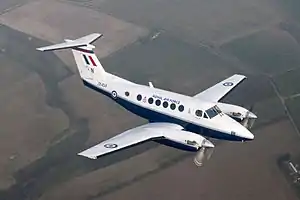 | |
| A King Air B200 of No. 45 Squadron Royal Air Force | |
| Role | Civil utility aircraft |
| Manufacturer | Beechcraft |
| First flight | October 27, 1972 |
| Introduction | 1972 (Military) February 1974 (Civil) |
| Status | Active service |
| Primary users | United States Air Force United States Army Royal Flying Doctor Service of Australia Royal Australian Air Force |
| Produced | 1972–present |
| Number built | 3,781 at end of 2015[1] |
| Developed from | Beechcraft King Air |
| Variants | Beechcraft C-12 Huron Beechcraft 1900 |
Beechcraft currently offers the 250 (design. B200GT[4]) and the larger 350i (B300[4]) models.[5] The 350ER (B300CER[4]) is available to government, military and commercial customers for special mission operations[6] such as aerial survey, air ambulance, flight inspection and surveillance.[7] The Beechcraft 1900 regional airliner was derived from the Model B200 King Air.[8]
The Super King Air family has been in continuous production since 1974,[9] the longest production run of any civilian turboprop aircraft in its class. It outlasted all of its previous competitors; the only other pressurized multi engine turboprop utility aircraft now in production is the Piaggio P.180 Avanti.[4]
Development
Super King Air 200
_Beechcraft_200_Super_King_Air.jpg.webp)

_Beechcraft_B200T_Super_King_Air.jpg.webp)
The Model 200 was originally conceived as the Model 101 in 1969, and was a development of the Model 100 King Air.[10][11] The Model 200 had essentially the same fuselage as the Model 100, with changes to the rear fuselage to accommodate a new T-tail (in place of the 100's conventional tail with all-moving trimmable horizontal stabilizer) and structural changes to allow higher maximum pressurization.[11] Apart from the T-tail, other changes included Pratt & Whitney Canada PT6A-41 engines rated at 850 shp (630 kW) instead of the 680 shp (510 kW) engines of the Model A100 then in production, and a wing of increased span and extra fuel capacity.[10][12] Overall, the 200 was 3 ft 10 in (1.17 m) longer than the A100, with wingspan 4 ft 3 in (1.29 m) greater, containing 60 US gallons (230 L) more fuel.[2][10][12][13] Maximum Take-Off Weight (MTOW) was increased by 1,000 lb (450 kg).[11] After protracted development including extensive wind tunnel testing of the design (especially of the T-tail which was tunnel-tested for 375 hours),[10] the first prototype flew for the first time on October 27, 1972;[14] a second prototype took to the air on December 15 the same year.[10] Three production aircraft were also built in 1972 and delivered to the U.S. Army;[15] these three were designated Model A100-1s by Beechcraft and were given the military designation RU-21J;[16] the first of some 400 T-tail King Airs to be ordered by the U.S. armed forces.[17] The 200 received civil certification in December 1973[18] and the first civil delivery took place in February 1974.[11]
In 1976, Beechcraft developed the Model 200T, a version configured for aerial surveying or reconnaissance.[15] The prototype was created by modifying a Model 200 aircraft, constructor's number (c/no.) BB-186;[15] the modifications included changes to the belly aft of the wing to allow photography with a vertical camera, provision for a surveillance radar in a pod under the fuselage, dome-shaped windows on the sides of the rear fuselage to allow observation directly below the aircraft by occupants, and a 50-US-gallon (190 L) usable capacity fuel tank on each wingtip to increase the aircraft's range.[15] Customers could specify any combination of these modifications when ordering a 200T; all 200Ts were Model 200s modified at the factory and given new constructor's numbers.[15]
The next model to appear was the Model 200C in 1979; this version had a large cargo door on the LH side of the rear fuselage with an airstair door similar to the Model 200's door built into it.[19] The door opening was 4 ft 4 in (1.33 m) high and 4 ft 4 in (1.33 m) wide,[2] allowing a large range of items to be loaded into the cabin. The Model 200C found favour with many operators who fitted them out internally as Air Ambulances. The 200C was built from scratch rather than as a modification of the Model 200.[19] The Model A200C military version was developed concurrently.[16] In 1981, a Model 200C (c/no. BL-24) was modified as the Model 200CT, fitted with the same wingtip fuel tanks as installed on Model 200Ts; there was only one 200CT, but it led to other aircraft after an updated version of the Model 200 entered production.[19]
This updated and improved version was the Model B200, which entered production in 1981.[10] It was fitted with PT6A-42 engines, still rated at 850 shp (630 kW), but with improvements that resulted in greater aircraft performance.[10] Other changes included increased maximum pressurization to 6.5 psi (450 hPa) differential and changes to the cockpit layout.[10] The Model 200C gave way to the Model B200C the same year, with the first Model B200T and Model B200CT being modified from a B200 and B200C respectively, the following year.[19] Commencing in 1984 the B200, B200C and their derivatives were fitted with a revised landing gear retraction mechanism, actuated by hydraulic rams powered by an electric pump installed in the LH wing.[10] This replaced the earlier electro-mechanical retraction system of gearboxes, driveshafts and chains and sprockets that was a throwback to the Twin Bonanza. At the same time the propellers fitted were changed from 3-bladed Hartzells to 3-bladed McCauleys.[10] Forty-seven B200Cs built that year were delivered to the U.S. military, with dozens more of a similar standard ordered in subsequent years, but not given official civil model designations.[19]
A total of 14 B200s were produced in 1989 and 1990 in a 13-seat high density configuration with a belly cargo pod; these were marketed by Beechcraft as a commuter airliner under the designation Model 1300.[8] Customers for this version included Mesa Airlines.[8][19] The propeller installation changed again in 1992, when Beechcraft started offering the option of having 4-bladed Hartzell or McCauley propellers, or 3-bladed Hartzell propellers; the 3-bladed McCauley propellers were no longer available.[20] From October 1995 Beechcraft offered an updated B200 with Electronic Flight Instrument System (EFIS) avionics, this was marketed as the "B200SE Super King Air" (for Special Edition). The following year the "Super" name was dropped from all marketing and advertising.[2] In October 2003, Beechcraft announced another avionics upgrade for the B200,[21] the Rockwell Collins Pro Line 21 suite.
The B200 remains in production, with a total of 13 built in 2009.[9] The B200C is available for order;[9] in January 2009 two B200Cs were delivered to the Royal Flying Doctor Service of Australia (RFDS).[22][23] The two B200Cs were the first examples delivered in about three years (the most recent B200Cs prior to this were two delivered in early 2006 for use as air ambulances in Scotland).[24][25] On May 21, 2007, during the 7th Annual European Business Aviation Convention & Exhibition in Geneva, Hawker Beechcraft (as the company was now known) introduced the Model B200GT updated version of the B200.[26] The B200GT is fitted with a new model of PT6 engine developed specifically for it by Pratt & Whitney Canada; while still rated at 850 shp (630 kW) the new PT6A-52 develops maximum power to an even higher altitude than the −42 it replaces, thus further improving aircraft performance. The B200GT and B200CGT with large cargo door were certified by the Federal Aviation Administration (FAA) on November 16, 2007[20] and by the end of 2009, 97 B200GTs had been delivered.[9] Hawker Beechcraft has elected to use new constructor's number prefixes for the B200GT and B200CGT; B200GTs are being built with the prefix "BY" and B200CGTs with the prefix "BZ".[20]
In 2014 Beechcraft announced the availability of an option (available at manufacture and for existing aircraft) to increase the MTOW of the B200GT from 12,500 pounds (5,700 kg) to 13,420 pounds (6,090 kg), marketed as the King Air 250EP (for Extra Payload). The upgrade puts the 250EP into the same weight class as the King Air 350, necessitating various system changes to meet certification requirements and a special rating for pilots.[27]
Model 200 military variants
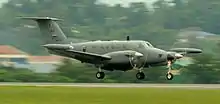
The United States Army, Air Force, Navy and Marine Corps have all flown versions of the Super King Air 200. As noted above some have been "off-the-shelf" civil versions, but the majority have been purpose-built for the military and were treated by Beechcraft and the FAA as a separate series, the A200 series. A significant minority of military versions are known purely by their military designations, with no FAA model designations being assigned to them, although they do have basically-equivalent civilian model counterparts. The military designation varies from service to service, but most are called C-12 Huron or UC-12. These are used for personnel transport. The Army also operates the RC-12 Guardrail series of aircraft for military intelligence missions.
The Canadian Forces (CF) took delivery of two second-hand early-production Model 200 Super King Airs leased from Awood Air in 1990. These were given the designation CT-145 under the CF's identification system and were used as multi-engine trainers, replacing Douglas C-47s. One was subsequently returned to the lessor and a third Model 200 placed into service in order that the two aircraft used would have the same cockpit layout.[28][29] The two aircraft were replaced by eight civilian-operated 90 Model King Airs in 1995.
The King Air B200 entered service with the Royal Air Force (RAF) in 2004 as a multi-engine trainer, replacing the Jetstream T1.[30]
The Royal Malaysian Air Force operates four B200T variants equipped with tactical command system, master search radar and forward looking infrared system.
PD 290
Beechcraft considered a jet-powered version in the mid-1970s. The first prototype King Air 200 was re-engined with Pratt & Whitney Canada JT15D turbofans in overwing nacelles.[15] Given the designation PD 290 (for Preliminary Design), the aircraft was flown in this configuration for the first time on March 12, 1975.[15] Beech did not pursue production, and the last flight was made on September 30, 1977.[15]
Super King Air 300/350
_Beechcraft_B300_King_Air_350_at_Sydney_Airport.jpg.webp)
The 200 series proved so popular that Beechcraft began work on a successor, with the Beechcraft designation Model 300 and marketed as the "Super King Air 300". The B200's airframe was "cleaned up" and more powerful engines (PT6A-60A, rated at 1,050 shp (780 kW)) were installed in redesigned cowlings (known as "pitot cowlings" due to the reshaped engine air intakes), with MTOW increased to 14,000 lb (6,400 kg). A Model 200 (c/no. BB-343) was modified to develop the updated systems to be used on the new model and flew in this configuration on October 6, 1981. The first flight of the prototype Model 300 took place on September 3, 1983 and deliveries commenced the following year. Because not all nations would then allow an aircraft of this type to be certified at an MTOW greater than 12,500 lb (5,700 kg), the Model 300LW was also developed at the same time, limited to the lower MTOW. Nineteen examples of a special version of the Model 300 were delivered to the FAA in 1987 and 1988. The first two were conversions of standard Model 300s, while the remaining 17 were purpose-built; since they were delivered the FAA has used the fleet to check the extensive network of navaids in the United States. 200 and 300 Series King Airs have been used for similar duties in several other countries, including Australia, Germany, Hong Kong (a B200C used for navaid calibration was the first aircraft to land at the then-new Chek Lap Kok Airport in 1996[21]), Norway, Sweden and Taiwan.
The King Air 350 is based on the King Air 300 with a 3.4 ft (1.0 m) span increase and winglets, a 2.9 ft (0.88 m) fuselage stretch for an over 17 ft (5.2 m) main cabin, long enough for double club seating.[31] By 1988, Beechcraft had begun work on the replacement for the 300, it was introduced in 1990 and initially marketed as the Super King Air 350. It has two extra cabin windows on each side and MTOW was increased again to 15,000 lb (6,800 kg); as the same regulatory situation that led to the development of the 300LW still existed, that model continued to be produced until 1994. Like the 200 and B200 before it, a version with a large cargo door was developed, the Model B300C marketed as the "Super King Air 350C". The first deliveries of this model also took place in 1990. In 1998, the UltraQuiet active noise canceling system,[32] made by Elliott Aviation, was added as standard equipment on all B300s.[33] In October 2003, Beechcraft announced that it would deliver future B300 and B300C King Airs with the Rockwell Collins Pro Line 21 avionics suite.[21]
The B300 model is still in production today (now marketed simply as the "King Air 350", the "Super" being dropped in 1996 as mentioned earlier), while the B300C is available for order; four were built in 2007[34][35] and Hawker Beechcraft announced on November 11, 2007 that it would deliver five to Saudi Arabia in 2008 for use as air ambulances.[36]
On June 13, 2005, Beechcraft announced at the Paris Air Show that it was developing the King Air 350ER version of the B300,[37] an equivalent to the earlier Model 200T and B200Ts of the 200 series. Changes include an increase of MTOW to 16,500 lb (7,430 kg), provision for surveillance equipment in a belly pod, the landing gear of the Beechcraft 1900 to handle the increased weight and provide ground clearance for the belly pod, and extra fuel capacity in the engine nacelles to increase range[38] (because of the B300s winglets, it was unfeasible to fit wingtip fuel tanks as found on the 200T and B200T). On November 11, 2007, Hawker Beechcraft announced that the 350ER had been certified by the FAA.[39]
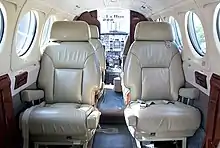
King Air 350i
In October 2008, Beechcraft announced updated versions of the B300 series, the King Air 350i, with improvements to the passenger cabin. The manufacturer claims that the noise level and overall comfort of the King Air 350i, 350iER, 350iC and 350iCER are now competitive with those of light jets. The cabin of the B300 series has been updated with controllers in the passenger seat armrests that dim the LED lights, darken the windows and control an iPod dock and a high-definition video monitor. The cabin also includes Universal Serial Bus (USB) ports, AC electrical receptacles and fold-out tables for each passenger in the eight seats fitted. Deliveries commenced in December 2009.[40][41]
The cabin sound level is reduced by 4 dB to 78-dB due to better insulation. More than 440 350i have been delivered in less than ten years. On a one hour trip, it is 10-15 min slower than a jet while burning 700–900 lb (320–410 kg) less fuel. It cruises at 292 kn (541 km/h) TAS at FL350 while burning 503 lb (228 kg) per h, and can reach 312 kn (578 km/h) TAS at FL240. The $1.8 million Blackhawk PT6A-67A upgrade offers a 68 kn (126 km/h) TAS faster cruise and up to 60% shorter time to climb.[31]
Direct operating costs are around $1,300-1,500 per hour, including a 900 lb (410 kg) average fuel flow per h. At 3,600 h, the first pair of engine overhauls cost $500,000-550,000, but second overhauls can cost $800,000-1.2 million. By September 2019, second-hand aircraft were priced between $3 million for early models to more than $4 million for late models.[31]
Model 300 military variants

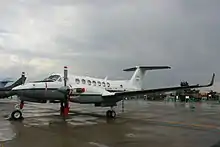
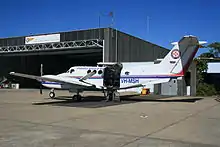
One special Super King Air B300C variant was built for the Swiss Air Force, with a modified belly to allow for aerial photography and a large observation window in the right side aft fuselage;[42][43] and given a c/no. with a different prefix to other B300Cs.
The Hawker Pacific aviation company of Australia purchased eight B300s between 2003 and 2005 for lease to the Royal Australian Air Force (RAAF), which were subsequently modified as navigator trainers.[44] Hawker Pacific later leased another three B300s to the Australian Army, replacing B200 and B200C Model King Airs. The RAAF has also utilized King Air 350 Special Mission as an interim replacement for the DHC-4 Caribou transports of No. 38 Squadron. The RAAF now operates 16 aircraft from both No. 32 Squadron and No. 38 Squadron.
The Japan Ground Self-Defense Force operates nine B300s, designated LR-2, in the reconnaissance and communications roles. The aircraft were delivered between 1998 and 2004 and include the last B300 built without the Pro Line 21 avionics package (c/no. FL-382).[45][46][47]
The Royal Bahamas Defence Force operates a single B300 on maritime patrol and reconnaissance duties.[48]
Beechcraft announced on March 6, 2007 that the Iraqi Air Force had ordered five King Air 350ERs[49] for delivery commencing late in 2007. Hawker Beechcraft exhibited a King Air 350ER at the 2007 Paris Air Show;[50] and at the Royal International Air Tattoo the following month. Photos of the aircraft, which were modified 2005-built B300,[51] showed visual features of the King Air 350ER including a belly pod, and enlarged engine nacelles[52] compared to the nacelles of standard B300 King Airs.
The United States Army has contracted for a number of King Air 300s to be acquired on the second-hand market and modified as ISTAR aircraft for use by Task Force ODIN in operational theaters.[53][54] As of late 2010, 11 such aircraft are registered to the U.S. Army.[55] Two Canadian-registered and owned King Air 300s, configured in the same manner have also been contracted for.[56][57]
Model 350ER (Extended Range)
Extended range special mission version for surveillance and reconnaissance operations, introduced at the Paris Air Show in June 2005. Features engine nacelle fuel tanks, heavy duty landing gear and increased maximum take-off weight of 7,484 kg (16,500 lb). Typical mission profile involves a 100 n mile (185 km; 115 mile) flight to on-station; low-altitude surveillance sortie for 7 hours 20 minutes; and return to base with 45 minutes' fuel reserve.[58]
By early 2010, Hawker Beechcraft was offering structured programme of upgrades for King Air 350ERISR. Accommodation includes two pilots above an armoured floor; sensor operator at console (port, forward facing) providing on-board analysis; club-four seating in centre section with port side table, satellite telephone and refreshment centre; and lavatory at rear.[58]
Four King Air 350CERs (Shadow R. Mk 1 in RAF service)[59] equipped for intelligence, surveillance, target acquisition and reconnaissance (ISTAR) missions over Afghanistan were originally were ordered for the RAF and later increased to six in July 2013.[60] Four more King Air 350s replaced the Royal Navy's Jetstream T2 observer trainers in 2011[61] and were designated Avenger T. Mk1.
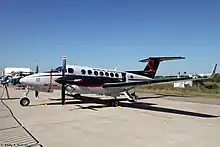
On October 3, 2018 the US State Department approved the possible Foreign Military Sale of three King Air 350ERs to the Government of Canada for an estimated cost of US$300 million. Intended to for a manned airborne ISR (MAISR) role, the Canadian 350ERs are expected to come with customer unique post-modifications for intelligence, surveillance and reconnaissance (ISR) operations.[62] Canada intends to use the aircraft to improve the ability of its Special Operations Forces Command (CANSOFCOM) to meet current and future threats, strengthen its homeland defense and the combined defense of North America and support coalition partners overseas.[63]
King Air 360 and 360ER
The King Air 360 and 360ER have a cockpit including an avionics upgrade, digital pressurisation and an autothrottle; and a modernised cabin featuring a 10% lower altitude pressure. First introduced in August 2020 and with deliveries expected from the fourth quarter, the model has the same range and weight specifications.[64] The 360 and 360ER models were both type certified in October 2020.[65]
King Air 260
On December 2, 2020, Textron updated the King Air 200 series with the 260, with certification and deliveries expected in early 2021.[66] The model has an improved autothrottle, a Multi-Scan weather radar, a range of 1,720 nmi (3,190 km) and a top cruise speed of 310 kn (570 km/h) with up to nine passengers.[66]
Modification and upgrade programs
Numerous aftermarket modifications and upgrades are available for 200 and 300 Series King Airs.[67] One company offers a Wing Front Spar Reinforcement Kit for 200 Series aircraft and a modification to replace the electro-mechanical landing gear retraction system of early-build aircraft with an electro-hydraulic system. Raisbeck Engineering out of Seattle, WA offers Enhanced Performance Leading Edges, Nacelle Wing Lockers, Ram Air Recovery System, Quiet Turbofan Propellers, High Flotation Gear Doors and Dual Aft Body Strakes.[68]
Another company offers a modification for the entire King Air line that entails reworking and extending the entire nose[69] to house a baggage compartment as well as the avionics normally found in the noses of King Air aircraft; while another offers winglets, similar to those of the B300, for 200 series and other 300 series King Airs.[70] In November 2019, Textron Aviation introduced a modified nose holding 12 cu.ft (0.34 m³) or 250 lb (113 kg) of cargo or aircraft equipment.[71]
A modification to install a forward looking infrared camera in an extended nose in B200 King Airs is available.[72] Other modifications available are to convert standard 200 Series King Airs to configurations equivalent to the Model 1300 or Model 200C and B200C King Airs; and to modify B300s (typically delivered with an eight-seat corporate interior) to allow more passengers and baggage to be carried.
Operational history
The 6,000th King Air was delivered on January 24, 2005.[37]
Australia's Royal Flying Doctor Service (RFDS) operates 34 King Air B200/B200C and B300C.[73]
Retired military King Airs have entered civil service with United States law enforcement and other government organizations such as State Police and Sheriff Departments; others are used by the Missionary Aviation Fellowship and subsidiary organisations.
It was intended to be replaced by the unusually designed Beechcraft Starship but only 53 were produced, ending in 1995, while the King Air continues to sell.
More than 1,800 King Air 200 series have been delivered during more than 40 years of production.[74] In early 2017 a used 2011 model King Air 250 was worth US$3 million and a late 2015 to early 2016 model was worth US$5 million, with an annual utilization estimated at 240 hours and 216 cycles, while a King Air 350i is US$800,000 to US$1 million more.[74]
By April 2017 sales of the King Air series were in decline with just 12 examples delivered in the first quarter of the year, compared to 26 in the same period of 2016, due to a weak international market for the design. The company expected the annual sales to be about the same as 2016, though, which totaled 106 in that year.[75]
By December 2020, nearly 7,600 King Air have been delivered, as the fleet surpassed 62 million flight hours in 56 years.[66]
Variants
In roughly chronological order, the 200 and 300 Series King Air variants and production numbers are:
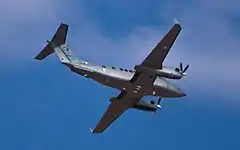
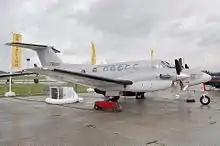
- Model 200
- Prototypes and initial production version, 858 built including those converted to Model 200Ts;[16] first prototype was converted to PD 290 jet aircraft[15] and first three production aircraft were delivered to U.S. Army as Model A100-1s.[16]
- Model A200
- First model purpose-built for U.S. military (Army and Air Force), 75 built.[16]
- Model 200T
- Version with optional wingtip fuel tanks, optional dome-shaped side windows in the rear fuselage, and modified belly to allow aerial photography. Prototype and subsequent aircraft converted from Model 200s and re-serialled; 23 delivered.[17]
- Model A200C
- Second military model built for U.S. Navy and USMC with cargo door in LH rear fuselage, 90 built.[76]
- Model 200C
- Civil equivalent to A200C, 36 built.[19]
- Model A200CT
- Third military model, built for U.S. Army with cargo door and wingtip fuel tanks of Model 200T, 93 built.[19]
- Model 200CT
- Civil equivalent to A200CT; one aircraft converted from Model 200C.[19]

- Model B200
- Current baseline production model; updated version of Model 200. 1,157 built as of the end of 2009 including those converted to Model B200Ts.[9][76] 12 aircraft delivered as Model 1300s.[19] Later models fitted with Pro Line 21 avionics[20]
- Model B200C
- Version of B200 with cargo door, available to order; 112 built as of the end of 2009,[9][19][23] of which 47 were built for the United States Air Force as C-12Fs.[19] Later models fitted with Pro Line 21 avionics.[20] A total of 65 other aircraft, similar in specification to the B200C, were built for the U.S. military.[19]
- Model B200T
- Version of B200 similar to Model 200T; aircraft converted from Model B200s and re-serialled. 23 delivered.[9][20][77]
- Model B200CT
- Version of B200C with wingtip fuel tanks; all aircraft converted from B200Cs and re-serialled. Eight delivered, to the Marina de Guerra del Perú and Israeli Air Force.[19][78][79] Another two similar aircraft built for the Israeli Air Force are without an official designation.[20]
- Model B200 (marketed as King Air 250)
- Includes new Hartzell composite scimitar propellers and third-party winglets and Ram Air Recovery System; can operate from shorter runways than the B200GT.[80][81][82][83]
- Model 300
- Two versions, the standard Model 300 with increased MTOW of 14,000 lb (6,300 kg) and the Model 300LW with MTOW limited to 12,500 lb (5,700 kg) to meet the aviation regulatory requirements of various countries; 247 built including 35 Model 300LW and including two Model 300s modified and another 17 built specifically for the FAA for use in navaid calibration.[84][9][77][85] The 300LW has a lower certified Take-Off Gross Weight of 12,500 lb for the European market related to tax.
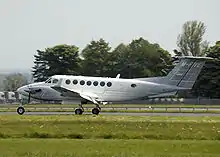
- Model B300 (marketed as King Air 350)
- Stretched model with two extra cabin windows each side of forward fuselage and winglets on wingtips;[85] in production as King Air 350i and King Air 350iER. 687 built as of the end of 2009, including 42 extended range versions delivered as 350ERs.[9] Later aircraft fitted with Pro Line 21 avionics.[20]
- Model B300C (marketed as King Air 350C)
- Version of B300 with cargo door; available for order as 350iC and 350iCER. 35 built as of the end of 2009 including one for the Swiss Air Force with modifications for aerial surveillance and five aircraft modified prior to delivery with underwing hardpoints and delivered as 350CERs.[9][20] Later aircraft fitted with Pro Line 21 avionics.[20]
- Model B200GT
- Updated version of B200; current civil production model. A total of 97 are built as of the end of 2009.[9]
- Model B200CGT
- Updated version of B200C; at least one built in 2016. Operated by Can-West Corporate Air Charters as of 2019.[86]
- Model B300 (marketed as King Air 350i)
- Updated version of B300 with interior upgrade; certified in December 2009.
- Model 1300 Commuter
- B200 configured as a regional airliner, with room for two crew and 13 passengers, fitted with two overwing emergency exits instead of the standard model's single overwing exit and an optional 455 lb (206 kg) belly cargo pod; a nose baggage compartment provided by relocating avionics from the nose to elsewhere in the aircraft. A total of 14 were built.[87]
- Blackhawk XP67A
- Re-engined with PT6A-67As and five-blade composite propellers instead of the PT6A-60A engines with unit power increasing from 1,050 to 1,200 hp (780 to 890 kW), boosting the maximum cruise speed by 50 kn (93 km/h) to 340 kn (630 km/h) and capable of climbing to 35,000ft in 19min; Blackhawk targets 30% of the 850 King Air 300 globally.[88]
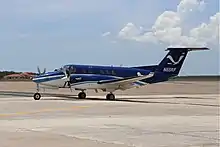
- Model 350CER
- Designed for use by the National Oceanic and Atmospheric Administration. Features two large downward-facing sensor ports that can support a wide variety of remote sensing systems, including digital cameras, multispectral and hyperspectral sensors, topographic and bathymetric LIDAR systems, and gamma radiation detectors.
- Model 360 and 360ER
- Models introduced in August 2020 with automatic pressurization, autothrottles and a revised interior.[89]
Operators
The most widespread turboprop business aircraft in the world, over 7,300 King Airs and Super King Airs have been delivered by May 2018, surpassing 60 million flight hours in commercial, military and special mission roles.[90] They are operated in more than 94 countries.[91] Almost 53% of the aircraft delivered have been from the 200/300 series family.
Civil operators

The King Air is used by many corporate and private users, it is also popular as a light transport liaison aircraft with both government and non-government organizations. It is also used by air-taxi and air charter companies.
Accidents and incidents
- February 21, 1980: A Model 200 operating as Advance Airlines Flight 4210 crashed adjacent to the runway at Sydney Airport, killing 13 people in the worst civil aviation accident in Australia since 1968.
- May 24, 1981: A Super King Air 200 of the Ecuadorian Air Force flew into a mountain with the loss of all 9 on board including Jaime Roldós Aguilera, the President of Ecuador.[92]
- February 17, 1993: a Turkish Air Force Super King Air B200 transporting Eşref Bitlis (the General Commander of the Turkish Gendarmerie) crashed minutes after taking off from the Güvercinlik Army Air Base in Ankara killing all five onboard and one on the ground.[93]
- September 4, 2000: After departing Perth, Western Australia, the pilot of a Model 200 Super King Air failed to respond to ATC after the aircraft climbed above its assigned altitude. It continued to fly across Australia for five hours before crashing near Burketown in northwestern Queensland, killing all eight on board. Dubbed the "Ghost Flight" by the media, an investigation concluded that the occupants likely became incapacitated due to hypoxia.
- January 27, 2001: A Super King Air 200 carrying members of the Oklahoma State University Basketball Team crashed in Colorado.
- February 26, 2004: President of the Republic of Macedonia Boris Trajkovski was killed with eight others in the crash near Mostar. The plane was a Beechcraft Model 200 Super King Air (registered Z3-BAB) operated as a transport aircraft of the Government of the Republic of Macedonia.[94]
- October 24, 2004: A Model 200 Super King Air crashed into mountainous terrain during a missed approach in Virginia. Several members of the Hendrick Motorsports team were on board and died in the crash.
- April 12, 2009: A privately chartered Super King Air 200 made an emergency landing by one of its passengers en route to Fort Myers, Florida after the pilot suffered a heart attack, dying instantly mid flight. The passenger, Doug White, had a licence to fly in a Cessna 172 Skyhawk, but had not flown in nearly 18 years at the time and never in any aircraft similar to the King Air. The landing was later described as being perfect with no injuries and the only death being that of the pilot.[95]
- October 30, 2014: A B200 King Air crashed at Wichita, Kansas; the pilot and three people on the ground were killed, six people were injured.
- December 22, 2015: A B200 King Air crashed at Indira Gandhi International Airport in Delhi, India. All ten occupants were killed; one person on the ground was injured.
- February 21, 2017: A B200 King Air struck the roof of a shopping center building and crashed just after taking off from Essendon Airport in Melbourne, Australia. All five on board were killed.
- July 30, 2019: A Pakistan Army King Air 350i crashed in Punjab, Pakistan killing all five aboard.
- September 1, 2019: A B300 King Air crashed into a resort in Calamba, Philippines. All nine occupants aboard were killed; two people on the ground were injured.
- July 15, 2020: A B350 crashed on Mount Artos, Turkey in Turkey, killing all seven on board.
Specifications
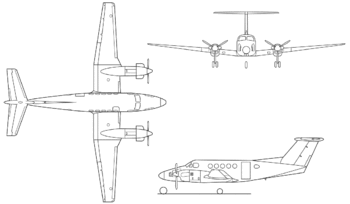
| Variant | 250[96] | 350i[97] | 350ER[98] |
|---|---|---|---|
| Crew | 1–2 | ||
| Capacity | 10 | 11 | |
| Length | 43 ft 10 in / 13.36 m | 46 ft 8 in / 14.22 m | |
| Span | 57 ft 11 in / 17.65 m | ||
| Height | 14 ft 10 in / 4.52 m | 14 ft 4 in / 4.37 m | |
| Cabin L × W × H | 16'8" × 4'6" × 4'9" 5.08 × 1.37 × 1.45 m |
19'6" × 4'6" × 4'9" 5.94 × 1.37 × 1.45 m | |
| MTOW | 12,500 lb / 5,670 kg | 15,000 lb / 6,804 kg | 16,500 lb / 7,484 kg |
| OEW[lower-alpha 1] | 8,830 lb / 4,005 kg | 9,955 lb / 4,516 kg | 9,455 lb / 4,289 kg[lower-alpha 2] |
| Useful load | 3,760 lb / 1,706 kg | 5,145 lb / 2,334 kg | 7,145 lb / 3,241 kg |
| Engine type (2×) | PWC PT6A-52 | PWC PT6A-60A | |
| Power or Thrust | 850 shp / 625 kW | 1,050 shp / 783 kW | |
| Maximum Cruise | 310 kt / 574 km/h | 312 kt / 578 km/h | 303 kt / 561 km/h |
| Ferry Range | 1,720 nm / 3,185 km | 1,806 nm / 3,345 km | 2,670 nm / 4,945 km |
| Takeoff | 2,111 ft / 643 m[lower-alpha 3] | 350i: 3,300 ft / 1,006 m | 4,057 ft / 1,237 m[6] |
| Ceiling | 35,000 ft / 10,668 m | ||
See also
Related development
Aircraft of comparable role, configuration, and era
- Cessna 425
- Cessna 441 Conquest II
- Embraer EMB 121 Xingu
- Evektor EV-55 Outback
- Mitsubishi MU-2
- Piaggio P.180 Avanti
- Pilatus PC-12
- Piper PA-31T Cheyenne
Related lists
References
- serial numbers list. technical publications. Beechcraft.
- "Raytheon Beechcraft King Air 200." airliners.net., July 30, 2006.
- Phillips 1992, p. 7-10.
- "2016 Business Airplanes Purchase Planning Handbook" (PDF). Business & Commercial Aviation. Aviation Week. May 2016.
- "Beechcraft turboprop Aircraft". Textron Aviation.
- "King Air 350ER". Textron Aviation.
- "Special Missions". Textron Aviation.
- Phillips 1992, p. 70.
- Hawker Beechcraft aircraft Serial Number Lists 1945 to present Archived April 11, 2009, at the Wayback Machine retrieved February 1, 2010.
- Phillips 1992, p. 65.
- Potts, Mike. "The King Air Story (Part 1)". avbuyer.com, May 2004. Retrieved: January 31, 2010.
- Phillips 1992, p. 64.
- "Raytheon 90/100 King Air." airliners.net. Retrieved: January 31, 2010.
- Jackson 2003
- Phillips 1992, p. 66.
- Phillips 1992, p. 83.
- Phillips 1992, pp. 84–85.
- Phillips 1992, p. 91.
- Phillips 1992, p. 84.
- FAA Beech 200 and 300 Series Type Certificate retrieved December 11, 2007.
- "Beech King Air Timeline." Archived December 3, 2010, at the Wayback Machine Wings Over Kansas. Retrieved: October 14, 2007.
- "Royal Flying Doctor Service of Australia 2007/2008 Annual Report." Archived July 22, 2010, at the Wayback Machine flyingdoctor.org. Retrieved: January 31, 2010.
- "BL-15". Australian civil aircraft register. Retrieved: January 31, 2010.
- "UK civil aircraft register." caa.co.uk. Retrieved: January 21, 2009.
- "Hawker Beechcraft B200C." Archived July 9, 2011, at the Wayback Machine Hawker Beechcraft Press Release Retrieved: October 16, 2007.
- "Model B200GT'." Archived July 9, 2011, at the Wayback Machine Hawker Beechcraft Press Release. Retrieved: October 13, 2007.
- Goyer, Robert (October 24, 2014). "Beechcraft King Air 250 Gets a Lot More Muscle". Flying. Bonnier Corporation. Retrieved May 18, 2017.
- Martin, Patrick. "Short histories of CAF aircraft types." Martin Slides. Retrieved: October 30, 2007.
- "Canadian historic civil aircraft register." Archived October 3, 2007, at the Wayback Machine tc.gc.ca. Retrieved: October 30, 2007.
- "King Air B200." Archived December 6, 2010, at the Wayback Machine RAF. Retrieved: November 17, 2012.
- Fred George (September 19, 2019). "King Air 350i: Fill The Seats, Fill The Tanks And Feel The Difference". Business & Commercial Aviation.
- "UltraQuiet active noise canceling system." Archived January 16, 2012, at the Wayback Machine Elliott Aviation. Retrieved: January 11, 2012.
- "Funding Universe." Raytheon History. Retrieved: October 16, 2007.
- "Turboprop aircraft." LAASdata.com. Retrieved: October 16, 2007.
- "Canadian civil aircraft register." Archived February 23, 2008, at the Wayback Machine tc.gc.ca. Retrieved: October 16, 2007.
- "Saudi Arabia air ambulances." Hawker Beechcraft Media Release. Retrieved: December 11, 2007.
- "History". Beechcraft. Archived from the original on March 12, 2017. Retrieved March 9, 2017.
- Berger, Jacky. "Raytheon Aircraft Company Certifies Heavy-Weight Beechcraft King Air 350." Archived October 17, 2007, at the Wayback Machine Wings Over Kansas News. Retrieved: October 14, 2007.
- "350ER certification." Hawker Beechcraft Media Release. Retrieved: December 11, 2007.
- "Hawker Beechcraft Corporation Goes Hi-Tech, Hi-Def with New Beechcraft King Air 350i" – Hawker Beechcraft Media Release. Archived July 11, 2011, at the Wayback Machine Retrieved: October 24, 2008.
- Grady, Mary. "King Air 350i Debuts At Sun 'n Fun." avweb.com, April 14, 2010.
- "King Air 300 Series." LAASdata. Retrieved: October 16, 2007.
- "Photo database." Airliners.net. Retrieved: October 16, 2007.
- "King Air." Archived October 27, 2007, at the Wayback Machine ADF serials. Retrieved: October 25, 2007.
- accessed via "Japan Ground Self-Defense Force." Archived April 3, 2007, at the Wayback Machine JGSDF Order of Battle. Retrieved: October 25, 2007.
- "King Air 350." Aerospace Technology. Retrieved: October 25, 2007.
- "King Air 300 Series." LAASdata. Retrieved: October 25, 2007.
- "Assets." Archived August 24, 2012, at the Wayback Machine Royal Bahamas Defence Force Equipment. Retrieved: November 17, 2012.
- "Iraqi Air Force 350ER." Hawker Beechcraft Press Release. Retrieved: October 14, 2007.
- "King Air 350ER at the 2007 Paris Air Show." Hawker Beechcraft Press Release. Retrieved: October 16, 2007.
- "N106R." FAA US civil aircraft register. Retrieved: October 16, 2007.
- "B300 c/no. FL-424." Airliners.net. Retrieved: October 16, 2007.
- "Photo of Task Force ODIN King Air 300." airliners.net. Retrieved: November 17, 2012.
- "Sierra Nevada King Air shows odd mods at static." Archived October 30, 2010, at the Wayback Machine ainonline.com, Retrieved: November 17, 2012.
- U.S. civil aircraft register online searches, using "Beech 300". Archived November 18, 2007, at the Wayback Machine faa.gov. Retrieved: November 17, 2012.
- "More on Canada (Maybe) Offering Civilian 'Ear in the Sky' Help in AFG." 'milnewsca. Retrieved: November 17, 2012.
- "Intelligence, Surveillance & Reconnaissance: New ISR Aircraft Canadian Forces 'CT-145Bs' or Contractor-Operated King Airs?" Archived June 28, 2010, at the Wayback Machine casr.ca. Retrieved: November 17, 2012.
- "Jane's by IHS Markit". janes.ihs.com. Retrieved October 5, 2018.
- "UK converts King Air 350s into ISTAR platforms." Archived April 14, 2009, at the Wayback Machine defence-solutions.co.uk, January 13, 2009. Retrieved: February 16, 2009.
- Hoyle, Craig (July 5, 2013). "RAF to receive sixth Shadow surveillance aircraft". Flightglobal.com. Retrieved October 27, 2015.
- "Royal Navy unveils its new King Air." key.aero. Retrieved: November 17, 2012.
- "Canada – King Air 350ER ISR Aircraft (Manned Airborne, Intelligence, Surveillance and Reconnaissance (MAISR) Platform) | The Official Home of the Defense Security Cooperation Agency". www.dsca.mil. Retrieved October 5, 2018.
- "US approves sale of King Air 350ER aircraft to Canada - Pentagon". Trend.Az. October 5, 2018. Retrieved October 5, 2018.
- Pilar Wolfsteller (August 4, 2020). "Textron introduces King Air 360". Flightglobal.
- O'Connor, Kate (October 6, 2020). "King Air 360 Earns FAA Type Certificate". AVweb. Archived from the original on October 7, 2020. Retrieved October 7, 2020.
- "Textron Aviation introduces the King Air 260 to its renowned turboprop lineup" (Press release). Textron. December 2, 2020.
- "A list of STCs available for King Air series aircraft." Archived February 8, 2008, at the Wayback Machine FAA website. Retrieved: November 17, 2012.
- "Raisbeck King Air Performance Systems." Archived July 15, 2011, at the Wayback Machine raisbeck.com. Retrieved: November 17, 2012.
- "STC No. SA00367SE." FAA. Retrieved: December 11, 2007.
- "STC No. SA01615SE." FAA. Retrieved: December 11, 2007.
- kate sarsfield (November 25, 2019). "Beechcraft King Air 350 gets nose modification". flightglobal.
- "STC No. SA01853LA." FAA Retrieved: December 11, 2007.
- "Our Fleet". Royal Flying Doctor Service.
- Fred George (February 24, 2017). "Used Aircraft Report: Beech King Air 250". Business & Commercial Aviation. Aviation Week.
- Grady, Mary (April 25, 2017). "King Air Sales Down". AVweb. Retrieved April 26, 2017.
- Phillips 1992, pp. 83–84.
- Phillips 1992, p. 85.
- "List of Israeli turboprops." Laasdata. Retrieved: February 6, 2010.
- "List of Peruvian turboprops." Laasdata. Retrieved: February 6, 2010.
- "Beechcraft King Air 250." Archived October 25, 2010, at the Wayback Machine hawkerbeechcraft.com. Retrieved: November 17, 2012.
- "Hawker announces new King Air model." bizjournals.com. Retrieved: November 17, 2012.
- "King Air 250 Gets Hartzell Composite Prop Blades." Archived November 6, 2010, at the Wayback Machine ainonline.com. Retrieved: November 17, 2012.
- "No Rise in Dublin Airport Pax Charges". AviationPros.com. Archived from the original on September 30, 2011. Retrieved October 27, 2015.
- Phillips 1992, p. 10.
- Phillips 1992, p. 67.
- "Canadian Civil Aircraft Register". Transport Canada. Retrieved: March 1, 2019.
- Pelletier 1995, p. 174
- Kate Sarsfield (August 28, 2019). "Blackhawk completes first King Air 300 engine upgrades". Flightglobal.
- Cook, Marc (August 4, 2020). "Textron Introduces King Air 360". AVweb. Archived from the original on August 5, 2020. Retrieved August 5, 2020.
- "Beechcraft King Air 350i rolls out improved situational awareness, navigation" (Press release). Textron Aviation. May 30, 2018.
- "Raytheon Air 200." Aerospace technology.com. Retrieved: July 30, 2006.
- "Bangs/Prangs." British Aviation Review (British Aviation Research Group), Volume 29, Issue 9, September 1981, p. S402.
- Accident description at the Aviation Safety Network. Retrieved on February 21, 2017.
- "List of Governmental aircraft of the Republic of Macedonia." aeroflight.co. Retrieved: August 14, 2008.
- "Passenger lands plane after pilot dies". msnbc.com. April 13, 2009. Archived from the original on April 21, 2020. Retrieved April 21, 2020.
- "King Air 250 Product Card". Beechcraft. 2016.
- "King Air 350i Product Card". Beechcraft. 2016.
- "King Air 350ER Product Card". Beechcraft. 2016.
Notes
- with one 200 lb pilot
- without accommodation
- FAR-23 base model, 12,500 lb MTOW
Bibliography
- Hoyle, Craig. "World Air Forces Directory". Flight International, Vol. 180, No. 5321, December 13–19, 2011, pp. 26–52.
- Hoyle, Craig. "World Air Forces Directory". Flight International, Vol. 188, No. 5517, December 8–14, 2015. pp. 26–53.
- Jackson, Paul. "Beech King Air B200". Jane's All the World's Aircraft 2003–2004. London: Janes Information Group, 2003, pp. 531–532. ISBN 978-0-71062537-3.
- Pelletier, A. J. Beech Aircraft and their Predecessors. Annapolis, Maryland, USA: Naval Institute Press, 1995. ISBN 1-55750-062-2.
- Phillips, Edward H., Beechcraft: Pursuit of Perfection, A History of Beechcraft Airplanes. Egan, Minnesota: Flying Books, 1992. ISBN 978-0-91113-911-2.
External links
| Wikimedia Commons has media related to Beechcraft Super King Air. |
- Official website
- Matt Thurber (January 1, 2013). "Pilot report: Long-legged King Air 350ER is a Flexible and Capable Turboprop". Aviation International News.